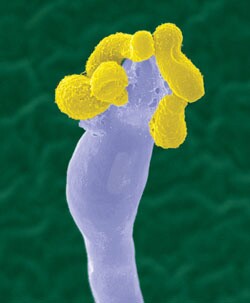A 13-year-old's science project helped solve the mystery of where fungi deadly to AIDS patients has been breeding in Southern California.
One-third of all AIDS patients in the world die from complications of an infection by the fungus Cryptococcus gattii. Its spores can affect that person's immune system, causing flu-like symptoms, pneumonia and even death.
However its source in Southern California has been unknown for more than four decades.
But three years ago, when then-13-year-old Elan Filler needed a science project, she reached out to researchers at Duke University who've been looking into where the fungi grows.
"We have known in many other areas around the world that Cryptococcus is associated with trees," says researcher Deborah Springer. However the tree that most scientists focused on -- eucalyptus -- proved inconclusive in tests.
Elan traveled around Los Angeles collecting samples from a variety of trees to have them tested for spores, "which was a huge help," says Springer, "because finding people to go out and sample is a limitation in these kind of studies."
What they found is that the fungi had been growing on Canary Island pine, American sweetgum and New Zealand Christmas trees.
Not every tree of those species is host to Cryptococcus, but Springer says this new information is helpful for those with compromised immune systems.
"I don't believe you should be scared of trees or anything in the environment," says Springer, "but with anything if you develop a cough and not feel good and it sticks around for a long period of time, then you should be concerned and have a discussion with your doctor that potentially you were in an area that put you at risk for a certain type of infection."



